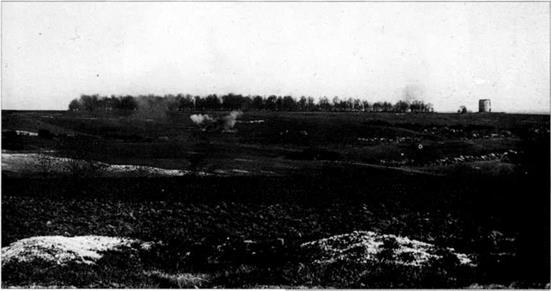Lieutenant ‘Wop’ May’s Adventure
|
Shortly before 11 am Allied time (German time was one hour ahead of Allied time at this period, ie: 1200 hours), on 21 April 1918, a field telephone rang in the HQ of the 53rd Australian Battery; Sergeant H E Hart answered. Gunner Fred Rhodes was on the line from the windmill FOP, watching the activity in and around Le Hamel. The duty officer. Lieutenant Punch, wished to advise the battery commander, Major Leslie Beavis, that two aeroplanes, a British one pursued by a German, had just passed his observation post and were heading west along the River Somme towards the 53rd Battery’s gun positions. The aircraft were living low-down in the thin mist and were just above the surface of the water.
As Oliver LeBoutillier later described it. even in perfect weather there were times when the Camel pilots flew home and kept themselves hidden from the Germans as they crossed the lines in the hilly Somme area, by simply flying low and using the mist as cover.
The distance between the FOP and the Battery being about ‘A miles (2 km), Major Beavis expected the aircraft to arrive in less than a minute. There was not much time to alert the Battery’s air defences which were two post – mounted Lewis guns under the orders of
Bombardier J S Secull. On this morning the company cook and assistant cook. Gunners Buie and Evans respectively, had been rostered for gun duty.
From the descriptions provided by three people, each one from a different location, it is possible to piece together what most probably occurred.
The two aeroplanes had approached the FOP from the direction of the village of Sailly-le-Sec and had been hidden from view until then by the trees of Welcome Wood and a bend in the river. Lieutenant Punch and the crew of the FOP, being on high ground and out of the mist, suddenly had a front seat view of the chase. The two aeroplanes resolved into a Sopwith Camel followed by a red Fokker Triplane. The observers watched them pass by and saw them enter the mist over Vaux-sur – Somme, re-appcar and then continue westwards towards the two Field Artillery Battery emplacements. Lieutenant Punch later said that the two aeroplanes had actually flown by him
|
|
|
|
|
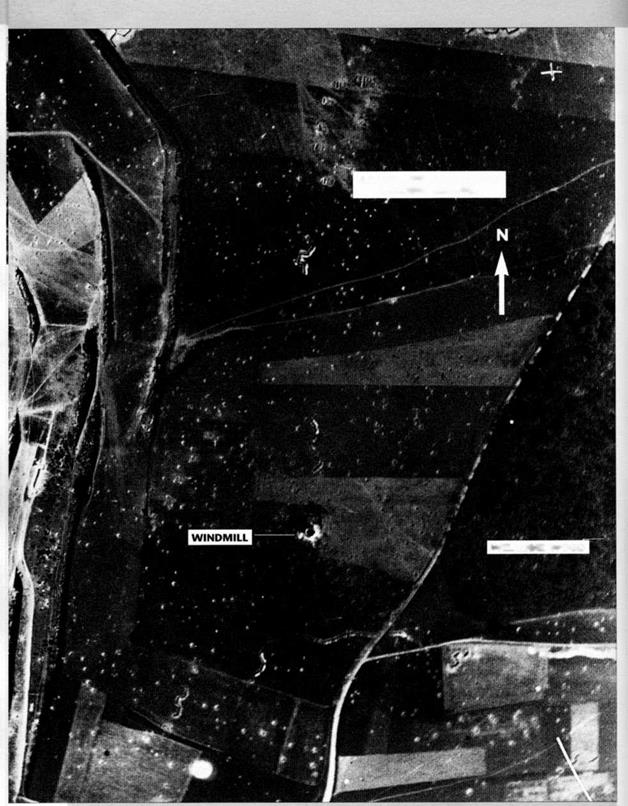
![]()
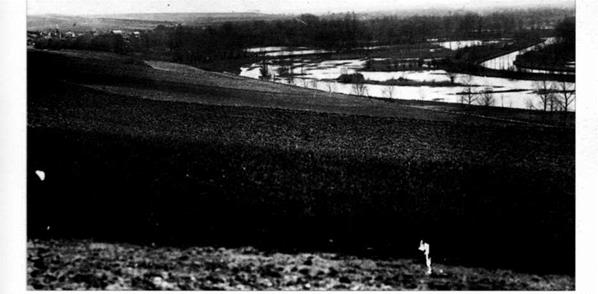
![]()
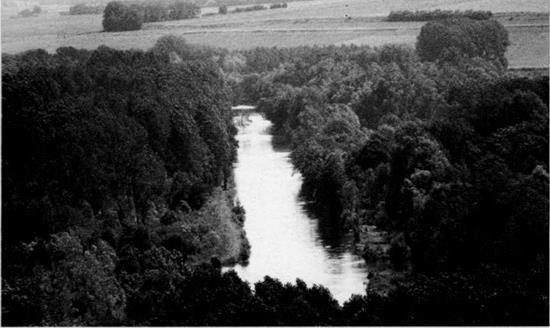
Top: Looking south-east over the Somme River and canal, on 29 March 1918, with Sailly-le-Sec on the far left. Picture taken from approximately the spot of the FOP position in front of the windmill by Welcome Wood.
Above: View to the south-east from the windmill
FOP trenches taken in July 1996 (as would be seen through binoculars). Coming towards them from the background to the foreground the observers saw a Camel being chased by a German Triplane. Even in 1918 the foliage was plentiful alongside the river.
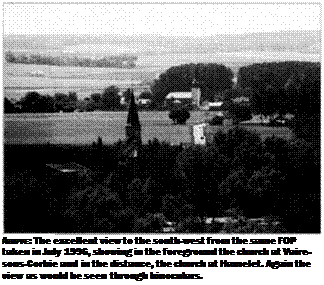
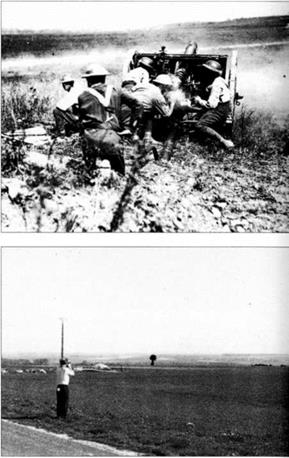
Above right: Australian 18-pounder gun in action.
JGI was brought into the area to help locate several batteries of these guns shelling the Hamel area prior to a new German offensive.
Right: Looking south today from in front of the Sainte Colette brickworks. Welcome Wood is off to the left and Vaux-sur-Somme is below the slope, out of sight. The lone tree, and scrub to the right, show the beginning of the slope down to the canal.
within pistol range. However, the mist overVaux prevented Punch from seeing a third Camel – Captain Brown – pass on the far side of that village on its way to intercept the red Triplane. The actual interception also took place outside their view, as did the turn made by May and von Richthofen by Vaux church. [Authors note: the authors have stood where Lieutenant Punch’s FOP used to be and looked east along the Ridge face. The view both to the left and the right of the canal is obstructed by trees and natural obstacles. It is only along a narrow path, straight ahead (and down), that the end of the valley can be seen in the distance. Any aeroplane that was not following that path would disappear from view from time to time. It is acknowledged that today the trees have grown, but in 1918 this area was not a devastated lunar-type landscape and the early spring foliage had started on nearby trees and saplings.)
Lieutenant-Colonel J L Whitham, in Vaux itself, had heard the noise of the air battle over Cerisy. Although he could not see any aeroplanes through the blanket of mist overhead.
confirmation of their presence had been coming for some time in the form of spent bullets fired in the fight dropping near him; in itself a dangerous situation, which did not lend itself to standing around gaping at the sky. Suddenly the loud engine noises typical of low-flying aircraft caught his attention and distracted some soldiers of his Battalion from their mid-day meal.
Those who did step outdoors to look up saw two aircraft approaching below the mist just above the surface of the mud fiats beside the canal. To avoid hitting the houses at the eastern edge of the village, the Camel took avoiding action and a wingtip came very close to grazing the tiles at the top of an ornamental gateway in front of one of them. Behind the Camel came a red Triplane equally low down and the two aeroplanes skimmed over the rooftops heading straight for the village church; from a distance its tower blended into the background. Just in time. May saw it and made a steep banking turn to the right, changing direction from west to north. The second aeroplane, the Fokker, which was not yet
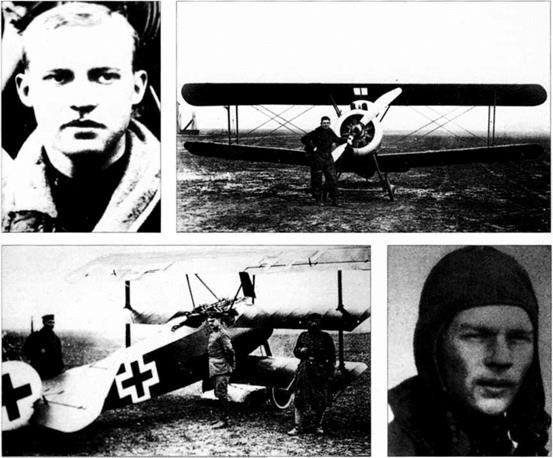 |
Top left: Lieutenant Wilfred ‘Wop’ May, 209 Squadron RAF.
Top right: Sopwith Camel.
Above: Von Richthofen’s red Triplane 425/17.
(This photo has in the past been captioned as under guard after capture. Unfortunately the soldiers are obviously German.)
Above right: Leutnant Wolfram von Richthofen,
Jasta 11.
close enough for effective shooting and whose pilot, doubtless, had just had an equally unpleasant surprise, did likewise. Some soldiers who had their rifles handy tired a few rounds at it.
The Camel continued north for a few moments, its pilot seeing the Morlancourt Ridge ahead of him. He would not want to start a climb over the Ridge, thereby presenting his pursuer a good shot as he came onto the skyline. Therefore he turned left, towards Corbie, keeping the slope of the Ridge to his right, the canal to his left. The Camel pilot would then begin to see the bend in the canal, the Ridge curving round with
it. The Triplane followed the manoeuvre.
Although those on the ground obviously would have no idea as to the identity of the airmen, some of the more experienced might have hazarded a guess seeing an all red Triplanc. The Camel was piloted by Second Lieutenant Wilfred May and the Triplane by Baron Manfred von Richthofen. Lieutenant-Colonel Whitham did not see the third Sopwith Camel either, as it flew at high speed and gradually curved round above the mist behind him to his south on its way to intercept the German machine. In following the line of flight of the two aircraft that flew over Vaux, he would, of course, be looking north.
From his newly-prepared trench on the brow of Morlancourt Ridge at Sainte Colette, Lieutenant Wood had been watching the air battle high up over Cerisy and Sailly Laurctte. One aeroplane had dived down to the river somewhere between Sailly-le-Sec and Vaux. A second aeroplane had followed it. Both had now passed Vaux and were skimming the lakes and mud flats on the north side of the canal. He had
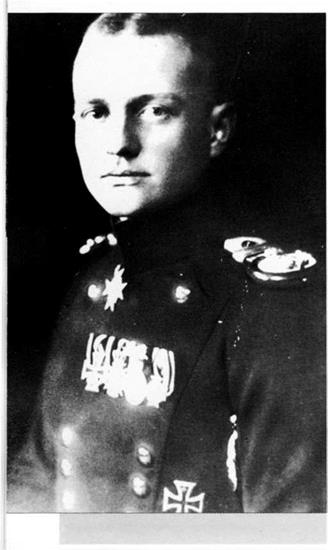 Manfred von Richthofen – the Red Baron.
Manfred von Richthofen – the Red Baron.
also seen a third aeroplane, now known to have been that flown by Brown, dive out of the air fight high up over Cerisy disappear behind the mist over Vaux and then re-appear from the south-east heading towards the second aeroplane. There had been some machine-gun fire and the third one had continued flying west down the valley towards the 53rd and 55th Batteries. The details of Woods testimony are given later in this work.
Lieutenant May. who had his hands full with the difficult and dangerous task of ‘hedgehopping’ with a tail wind, and a gusty, strong one at that, had to maintain a sharp look-out ahead. That he did not crash by touching the water with his wheels or brushing a tree with a wingtip is a tribute to his Advanced Training instructors. May’s intense concentration on things ahead
unfortunately prevented him from seeing Brown’s attempt to rescue him. Even if he had heard any firing, he would most probably have taken it to be from the Triplane behind. Therefore, instead of using his superior speed to escape whilst von Richthofen was distracted, he continued to zigzag. At ground level a Fokker Triplane was about Ю to 15 mph slower than a new Bentley-engined Camel. This Triplane pilot was obviously well aware of that for he expertly followed the basic direction of the faster Camel and thereby gradually shortened the distance between them.
On their way down the valley, the two aeroplanes had to pass in front of the defensive positions which various machine-gun companies had dug into the sloping (south-facing) face of the Morlancourt Ridge. The surprise of the Vickers machine gunners was such that there ь no record of any having gone into action. One Vickers crew opened fire with their personal rifles as there was not enough time to fit a belt into the machine gun.
What appeared to be just another normal bend in the canal, suddenly developed into the sharp 90° turn of the river from due west to due south. Trees on this bend would mislead a pilot not expecting anything other than a ‘kink’ in the canal. Only as he entered it would he see the ‘kink’ as a much sharper turn. May was now suddenly confronted by the towering, steep slope of the Ridge face as it curved south with the river. He was faced in those split seconds with three options: turn sharply left (south, which led to German-held territory): climb over the crest directly in front of him; or misjudge either one and die in the crash. The strong tailwind made a short 45° straight climb safer than a steeply banked 90° turn to the left. The powerful Bentley engine could handle such a climb but the guns of the Triplane behind him were another factor not to be overlooked. Pilots who have flown a replica Bentley-engined Camel in recent years testify to the power of the aeroplane and its climbing ability at full throttle. May made his choice and hauled up over the Ridge.
The windmill FOP observers, who were by this time looking from behind (most probably through binoculars at this stage) and thus had little sense of forward motion, saw the Camel reappear beyond the mist and then seem to stand on its tail and climb. The Triplane followed suit some way behind. The observers were surprised that the Triplane pilot did not shoot down this easy target. One later opined that at the time he had taken the German pilot as being a sporting fellow who
had given his adversary a chance. The truth was revealed later that day once the Triplanes guns were examined bv a weapons expert from 3 AFC’ Squadron.
It would appear that during the skirmish with the RE8s a short time earlier a cartridge with a faulty primer and a flimsy case had been fed into the breech block of the left-hand gun. The pilots efforts with the extractor mechanism to eject the cartridge had caused its case to split thus creating a jam that could not be cleared in the air. In armourers terminology it was a ‘number three stoppage*. At another time during that morning’s combat, a further disaster had occurred; the firing pin of the right-hand gun had fractured. (One of the authors has seen and held the lock from this actual breech block [see colour photo|, and if one shakes it one can hear the bit of the broken pin rattle.) This fault would still permit the gun to fire but only two or three rounds at a time. Automatic action would then cease and the firing mechanism would need to be re-cocked manually. With an expert marksman behind the gun. two or three shots would be sufficient, provided that he could get close enough to his quarry to make them tell. At the moment when such an easy target appeared in front of him, Richthofen probably had his mind occupied trying to handle an unexpected, dangerous, steep climb, avoid a mid-air collision and check that no-one was on his own tail – and all at the same time! (See Appendix I)
The machine gunners on the slope saw the Camel barely clear the tree-tops and half-turn to the right (north-west). It was still followed by the Triplane which, although slower, could climb much better.
The activities of the two aircraft had, one by one, attracted the attention of two German artillery observers, Leutnant Fabian and Leutnant Schonemann, and of a German infantry officer, Hauptmann A Roster. When the two aircraft crested the Ridge they came into clearer view and the German officers, quite independently, focused their telescopes on the scene.
Von Richthofen was also being watched from the air. Leutnant Hans Joachim Wolff (usually referred to as just Joachim Wolfi) had been watching the chase from well above until the all-too familiar rak-ak-ak sound caused him to turn and defend himself. During the time that he had spent in wondering what his commander, whom he had seen chasing the Camel, was up to, he had forgotten to pay regular attention to his own rear. Twenty bullet holes ripped through a wing as a penalty.(l)
Now that the two aircraft had crested the Ridge, the soldiers of the Nth Field Artillery Brigade, which was part of the 5th Divisional Artillery, had the best view of all. Soldiers from other units were also stationed in that area. Their purpose was to man the Heilly Sector strong point in the event of a German attempt to clear the path to the river by launching an attack on the forward defences. The strong point was actually a network of trenches which formed a reserve position about two miles behind the advanced positions where the fighting would begin. It had been carefully sited on the higher ground to the north-east of Sainte Colette where nature had provided a good natural defensive position against an attack from the south.
The Allied ground forces in that area totalled around 1,000 men, and most of them, from private to general, now had a grandstand view of the events as they unfolded. Not a single one of the several reports submitted that morning by members of the 5th Division mentioned the presence of a third aeroplane within their immediate limits of visibility. The next day, or even later, in response to specific questions, a few witnesses stated that they had seen another aeroplane (one even said aeroplanes), one mile or further away but had not mentioned it in their reports because it had not been involved in the action. By that is meant the part of the action which they had seen. From various locations specified for that aircraft, it is obvious that more than one had passed by in the distance around that time. It is quite likely that the aeroplane seen by some to the south and then later, by others, to the west over Corbie church was not the same one. Captain Brown does not seem likely to have been the pilot of the west-flying Camel as when he approached von Richthofen he was well below the line of sight. The probable occupant was Captain ‘Boots’ LeBoutillier.
When not actually firing, the 18-pounder guns of the 53rd Artillery Battery were hidden beneath camouflage nets. This procedure had been successful for. although the Germans knew that there was artillery on the far side of the Morlancourt Ridge, they did not know exactly where the guns were sited. A lucky chance view
(1) Wolff in fact was credited with a Camel shot down at 1150 am (German time) south of Hamelet. which was over the Allied side of the lines. It was the seventh of ten victories he would score before being killed in action on 10 May in combat with SE5s of 24 Squadron.
from a German observation aeroplane could alter that situation and the gunners were taking great care for their guns not to be seen. As the Camel and the Triplane made their half turns to the right and flew along the top of the Ridge towards the hidden gun positions down the slope beyond, Lieutenant-Colonel Fitzgerald and some members of the gun crews noticed the unusual shortness of the bursts of fire from the chasing German aircraft. More than two witnesses claim to have observed the German pilot moving forwards and backwards in his cockpit immediately before he fired each short burst. This body movement conforms to that required to cock a firing mechanism manually.
Hollywood film-makers would have us believe that guns on WW1 fighter aircraft needed always to be cocked before they could be fired. It looked dramatic but was not true to life. The only need to cock a machine gun manually was to fire the first bullet. The recoil action of the breech automatically re-cocked the gun for further firing. Von Richthofen was only doing it now because he had a gun problem and was not getting automatic re-cocking.
Adding to von Richthofens problems was the strong east wind blowing that morning which was causing a gusty up draught along the face of the Ridge. This created heavy turbulence at the crest which made it difficult for him to hold the Camel in his gun sights long enough for effective shooting at anything other than the point-blank range which the Baron was obviously seeking.
With the Fokker once more behind him and hearing the occasional Rak-ak-ak sound of bullets passing close by or even striking the fabric of his wings, Wop May must have expected the apparently inevitable shots to hit his back at any moment. Suddenly things became quiet and stayed quiet. It appears that a cartridge with a defective primer had this time been fed into the breech of the right-hand gun and it was now completely out of action. Von Richthofen at this point must have decided to desist and head for home. May later stated that after things had been quiet for a while he risked a look behind. It was a big risk, for to do so he had to turn his aircraft at least 30° to one side or the other. This would slow his speed down and at the same time increase the size of the target which he presented to his attacker. To his surprise and no doubt relief, the sky was clear. He could find no-one behind him or even near him.
For May to establish to his own satisfaction that there was indeed no Triplane on his tail, higher, lower, to his right or to his left, took at least ten seconds. To find an aeroplane in flight is not so easy as widely believed by armchair-pilots, even when it is known to be in the vicinity. Lieutenant May mentioned this in one of his articles on this day’s events. In Canadian Aviation, April 1944, he wrote:‘My experience was that it was very difficult to see an aircraft in the air.’ Human eyes have to focus on the distance before an object in line with them can be seen. If the sought aeroplane blends in with the landscape, many seconds may elapse before a relative motion against the background indicates its presence. (The reader who wishes proof of this is invited to study the dust jacket of this book from close up and then from a distance. May’s Camel blends into the background. This effect was not intentional. The first version of the painting had the Camel in its correct colour but it could hardly be seen against the vegetation – even by the authors who knew where to look. They had to request the artist to lighten its colour.)
May finally located the Triplane. It was far away to his right (east) near Sainte Colette and appeared to be out of control. Several interviews with May have been published over the years and in two he includes the detail that he saw the Fokker spin for one and a half turns followed by a cloud of dust when it slammed into the ground. Witnesses on the ground say that the Fokker made a quarter turn or a half turn as it slid along the rough surface of the field where the Sainte Colette artillery FOP was located. When seen from a distance in a slanting view, the height and the exact position of a low-flying aircraft are very difficult to judge, even for an expert. Analysing what happened, it appears that May caught sight of the Triplane as it spun around to the left at the end of its slide along the ground. Remember too. he was just getting used to the idea that he was no longer facing imminent death. From his position above and some way off he would have had the best view of the amount of turning to the left. One and a half turns are quite normal for a ‘ground loop’ and would indeed have raised a cloud of dust. May’s story matches reality.
One of May’s other accounts of this day’s actions includes more detail. He said that being hardly able to believe his own eyes, he flew over to Sainte Colette and confirmed that the Triplane had indeed crashed. He then turned and headed towards Bertangles looking around on his way for some explanation. As he neared Bonnay he spotted Captain Brown’s Camel above him. This has the ring of truth for he would not immediately have caught sight of an aircraft he did not know was around, but once spotted, the two streamers at the tail immediately identified it and its pilot.
The rotations (ground loop) of the Triplane on the ground and the formation of the cloud of dust took time too. Somewhere between 30 to 50 seconds total time must have elapsed between the beginning of the quiet period and the identification of Browns Camel above him. By then May was about a mile to the west of the Triplane’s crash-landing site. With most of those on the ground looking to the east or to the south, where, relative to their position, the Triplane had come to grief, it is not surprising that only two or three men reported seeing a Camel over Corbie church about one mile away to the west.
The experienced Captain Brown had a well- deserved reputation for looking after his men and Lieutenant May instantly concluded that, not very long ago and quite unseen by himself, his flight commander had been his saviour. A grateful May followed him back to their base at Bertangles aerodrome. Brown, May, Lieutenant Francis Mellersh and Lieutenant W J Mackenzie, were all logged as having landed at 1105 hours.
Historians were reminded (1995) by the late Ed Ferko in his booklet Richthofen, (Albatros Publications Ltd) that a German balloon observer, Joachim Matthias serving with Bullonzug 50, wrote an account in 1928 of the chase as he interpreted it from his lofty perch abut 15 kilometres away. In all essentials, it agrees with the foregoing.
Lieutenant May told his story several times with varying amounts of detail. It, logically, included pieces of the action which he had not personally witnessed but which had become familiar to him over the years. Considering his state of panic at the time, he did quite well in remembering as much as he did of his own part in the drama
unfolding around him.
Although Captain Brown clearly stated in his second Combats in the Air report that the location of his attack on the red Triplane was Vaux-sur-Somme, it has been assumed that this meant east of it; that is in the direction of German-held territory. This may also have been assumed due to the suggestion in many paintings that there was a chase along the canal, with Brown following the Triplane, which was following May. It also explains why some people say they saw the second Camel while others say there wasn’t one, due to the fact that everyone assumes they are all talking about the second Camel being to the rear of the other two machines heading down the canal.
Because the observers in the FOP near the old stone windmill east ofVaux did not see Brown’s attack, it has traditionally been believed as having occurred even further east – closer to Sailly-le – Sec than to Vaux, whereas it was further west.
With the traditional belief in mind, a comparison of May’s basic story with the terrain over which he flew and with the time factor involved has. until now, produced a puzzle. There seemed to be a gap in the narrative about a mile long and one minute wide between Captain Brown’s rescue attempt and von Richthofen’s cloud of dust.
John Coltman’s collection of replies to his enquiries produced the answer. Captain Brown did not err; he did indeed make his attack in the locality otVaux-sur-Somme, but it was to the west of it, low down, round the bend and out of sight of the machine gunners on the slope before the sharp southwards turn of the river by Corbie. There were several witnesses, and their stories will be told in a later chapter. The time factor correction has a positive effect on several other aspects of the story which until now have been a little cloudy, and will be revealed in due course.











